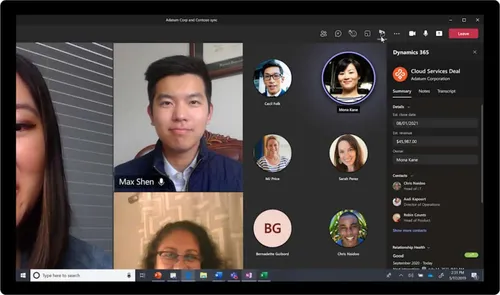
Knowledge base
July 16, 2021
Microsoft Teams users get license-free access to Dynamics 365 data
Microsoft is removing what is called a “license tax” to encourage broader access to sales and customer service data through the Teams collaboration app. But integration remains a work in progress, analysts say.
Microsoft Teams users can now access Dynamics 365 data without the need for CRM platform licenses.
Microsoft has already moved in recent months to deepen the ties between Dynamics 365 and the team collaboration app; in March, the company added the ability to embed Teams chat in the Dynamics 365 app, while improving access to data from Teams.
At this week’s Inspire event, Microsoft announced that all Teams users will now have access to Dynamics data from the collaboration app, regardless of whether they have a Dynamics 365 license. Administrators can set up permission and access rules to restrict access to customer records.
“Dynamics 365 users can now invite anyone in the organization to view and collaborate on customer records within the flow of a Teams chat or channel,” said Jared Spataro, corporate vice president for Microsoft 365.
By eliminating the “license tax” that had previously prevented customers from using the available integration, CRM data can be shared with more employees, he said. That would allow sales and customer service agents to communicate with colleagues who don’t routinely use the CRM tool, allowing financial teams to share purchase order and payment information with sales staff, for example.
The announcement “helps strengthen microsoft’s growing ties between Teams and Dynamics 365,” said Angela Ashenden, chief analyst at CCS Insight. It can also help Dynamics 365 customers drive broader adoption, without having to invest in additional licenses for occasional or irregular users, she said.
Wayne Kurtzman, research director at IDC, said Microsoft is positioning Teams as the “starting point” for employees to get work done. “While it is a work in progress with some UI challenges, the integration of Dynamics 365 indicates that Microsoft considers the importance of collaboration in the enterprise – and for all employees and across all devices,” he said.
Microsoft also announced that Dynamics users can now add a Teams meeting when creating an appointment and capture and save teams meeting notes for later access in the Dynamics record timeline.
Broader team integration is a growing priority for Microsoft. This includes new ways to communicate with SAP’s enterprise resource planning (ERP), Teams HR, and CRM software, announced in January, that allow SAP users to share information such as vendor data with colleagues without switching screens.
Earlier this month, the Salesforce app was made available to Teams, giving sales and service teams that use Salesforce Sales Cloud and Service Cloud access data from Microsoft’s collaboration app.
Microsoft’s CRM rival Salesforce appears to be following a similar path by integrating its core business software products with Slack – a competitor to Microsoft Teams. Salesforce announced plans last year to acquire $27.7 billion, and that deal will be finalized later this month.
By continuing to bind Teams and Dynamics more closely together, Microsoft can strengthen its position over Salesforce and Slack as soon as that deal goes through.
“Ultimately, I think it’s likely that Teams will become the default interface (or at least the access point) for Dynamics 365 for most users, further blurring the line between collaboration applications and line-of-business apps in the Microsoft portfolio,” Ashenden says. .
“Given the success of Teams, it’s easy to see why Microsoft would want to drive this, and given Salesforce’s acquisition of Slack, it’s a trend that will become the norm pretty quickly.”
Source: computerworld
Want to know more?

Related
blogs
Tech Updates: Microsoft 365, Azure, Cybersecurity & AI – Weekly in Your Mailbox.









